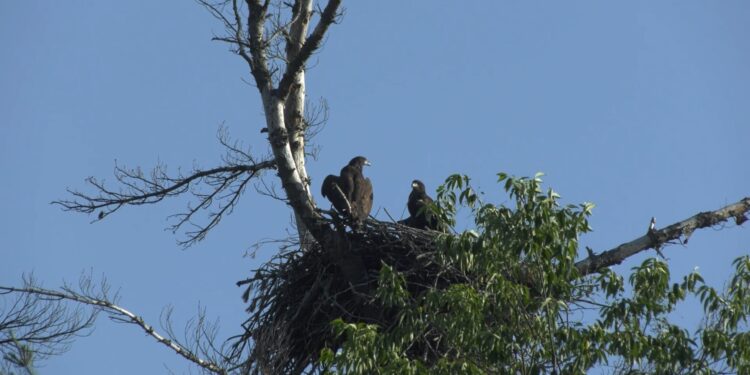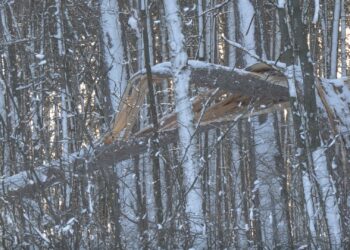Norway, Mich. (WZMQ) – Some whitewater rafting tourists from Florida were treated to a rare and majestic sight as they stopped along a dirt road to quietly observe two growing bald eagle babies in their nest. Natale VanPelt, age 13, Trevor VanPelt, age 14, Aislinn Fallon, and Thomas Vilan, marveled at the timely appearance of the eaglets.
According to fourteen-year-old Trevor VanPelt of Chicago, the eaglets were very young, not even having their white spot yet, which indicated to him that they were less than three years old. They were unable to fly at this stage. Trevor initially didn’t notice them, but his mom alerted him to their presence. He said, “When we were passing them the first time, I didn’t even see them. But my mom was like look! Look! Look!”
For his younger sister, Natale VanPelt, this was her first time seeing an eagle. She described them as “kinda big but, they were medium.” Aislinn Fallon of Tampa Florida found it particularly fascinating to see an eagle’s nest, especially during the 4th of July weekend. She exclaimed, “What better time to see an eagle’s nest?”
Thomas Vilan, who was used to seeing eagles in Florida, appreciated the opportunity to see them in a different setting. He mentioned that while eagles were common in the Everglades, it was nice to spot them perched on the side of the road in this area. He said, “Coming from Florida, you do see a bunch of eagles everywhere, and stuff like that. I mean, if you go down to the Everglades. But over here it’s really nice that you can see. We just saw on the side of the road, just perched. Two big – big birds.”
It’s important to note that the U.S. Fish and Wildlife Service guidelines suggest staying at least 330 feet away from an active Bald Eagle’s nest. Despite the excitement of witnessing the growing eaglets, it’s imperative to respect their habitat and ensure their safety.
Bald Eagles typically lay one to three eggs per clutch, with two eggs being the average, although there have been documented cases of successful clutches with as many as four eggs, according to the American Eagle Foundation. As the eaglets continue to grow, they will likely begin branching, which is a precursor to flying, at around nine to ten weeks old. By about 14 weeks of age, they will take flight into the land of liberty. While it’s exciting to witness their development, it’s crucial to adhere to the guidelines set by the U.S. Fish and Wildlife Service.


















